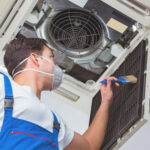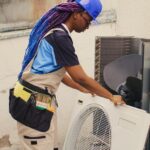
How to Choose the Right Air Purification System
How to Choose the Right Air Purification System
Air purification systems have become essential in today’s world, offering a breath of fresh air amidst rising concerns about indoor air quality. With an array of options flooding the market, selecting the right one can be daunting. However, fear not! In this guide, we’ll navigate through the maze of air purification systems, helping you make an informed decision. From understanding different types to assessing your specific needs, we’ll equip you with the knowledge needed to breathe easy and choose the perfect air purification system for your home or office.
Understanding Air Purification Systems
Air purification systems play a vital role in enhancing indoor air quality by eliminating a wide range of pollutants and contaminants. Employing diverse technologies like HEPA filtration, UV-C light, activated carbon, and ionization, these systems target and neutralize harmful particles effectively. Each technology operates uniquely, tackling specific pollutants with varying efficiency levels.
Delving into the intricacies of these mechanisms equips consumers with the knowledge necessary to make informed decisions when selecting an air purification system tailored to their requirements. Ultimately, understanding the workings of air purification empowers individuals to create environments characterized by cleaner, healthier air for themselves and their families or colleagues.
Importance of Indoor Air Quality
Indoor air quality significantly impacts our health and well-being, yet it often goes overlooked. Poor indoor air quality can lead to various health issues, including respiratory problems, allergies, and even long-term illnesses. Factors such as dust, pollen, pet dander, mold spores, volatile organic compounds (VOCs), and airborne pathogens contribute to indoor air pollution.
Recognizing the importance of maintaining high indoor air quality is the first step towards creating a healthier environment for yourself and your loved ones. Investing in an effective air purification system is a proactive measure to mitigate indoor air pollutants and promote better respiratory health.
Types of Air Purification Technologies
Air purification technologies encompass a spectrum of methods, each targeting airborne contaminants through distinct mechanisms. Ranging from mechanical filtration to chemical absorption and electronic ionization, these technologies offer diverse approaches to air purification. HEPA filters, renowned for their exceptional particle capture efficiency, stand as a staple in many systems, alongside UV-C light, activated carbon, ozone generators, and ionizers.
Understanding the nuances of each technology is crucial for selecting the most suitable solution for your indoor environment. By assessing the strengths and limitations of different technologies, individuals can make informed choices to ensure optimal air quality in their homes or workplaces.
HEPA Filters: The Gold Standard
HEPA filters stand as the pinnacle of air filtration technology, earning their reputation as the gold standard. Renowned for their exceptional efficiency, these filters can capture particles as tiny as 0.3 microns with a remarkable success rate of 99.97% or higher. Functioning through mechanical means, HEPA filters employ a dense network of fibers to trap airborne contaminants as air courses through them.
This robust filtration mechanism makes HEPA filters highly adept at eliminating a spectrum of indoor pollutants, including dust, pollen, pet dander, mold spores, and bacteria. Opting for an air purification system equipped with HEPA filtration ensures unparalleled air quality, providing reassurance that your surroundings remain free from harmful airborne particles.
UV-C Light: Killing Germs at Their Source
UV-C light technology harnesses the power of ultraviolet radiation to neutralize and destroy harmful microorganisms such as bacteria, viruses, and mold spores. Operating at a specific wavelength (typically 254 nanometers), UV-C light penetrates the cell walls of these pathogens, disrupting their DNA and rendering them unable to replicate or cause infection.
By targeting germs at their source, UV-C light effectively eliminates the risk of airborne illnesses and helps maintain a clean and healthy indoor environment. Integrating UV-C light technology into air purification systems provides an added layer of protection against infectious agents, making it particularly beneficial in healthcare facilities, schools, and other high-traffic areas.
Activated Carbon: Eliminating Odors and VOCs
Activated carbon, also known as activated charcoal, is a highly porous material that excels at adsorbing a wide range of organic and inorganic compounds from the air. Unlike absorption, which involves the physical trapping of molecules within a material, adsorption occurs when molecules adhere to the surface of the adsorbent. This property makes activated carbon ideal for removing odors, gasses, and volatile organic compounds (VOCs) from indoor air.
Common sources of VOCs include household cleaners, paints, adhesives, and building materials. By incorporating activated carbon filters into air purification systems, unpleasant odors are neutralized, and harmful VOCs are effectively removed, resulting in fresher, cleaner air for occupants to breathe.
Ionic and Ozone Generators: Controversial Choices
Ionic and ozone generators are two types of air purification technologies that have sparked controversy due to potential health concerns. Ionic generators release negatively charged ions into the air, which attach to airborne particles, causing them to fall to the ground or stick to surfaces. While this can improve air quality by reducing airborne pollutants, some studies suggest that high levels of ozone produced as a byproduct may pose risks to respiratory health.
Ozone generators, on the other hand, intentionally produce ozone molecules to neutralize odors and kill germs. However, prolonged exposure to ozone can irritate the respiratory system and exacerbate asthma symptoms. When considering these technologies, it’s essential to weigh their potential benefits against possible risks and consult with experts to make an informed decision.
Assessing Your Air Quality Needs
Assessing your air quality needs is the crucial first step in selecting the right air purification system for your home or workplace. Start by identifying potential sources of indoor air pollution, such as dust, pet dander, pollen, mold spores, and volatile organic compounds (VOCs). Consider any existing respiratory conditions or allergies among occupants, as well as specific concerns such as odors or germs. Next, evaluate the size of the space you wish to purify and the frequency of air exchange required to maintain optimal indoor air quality.
Additionally, factor in noise levels, energy efficiency, and any desired additional features when comparing different air purification systems. By thoroughly assessing your air quality needs, you can narrow down your options and choose a system that effectively addresses your specific concerns.
Size Matters: Choosing the Right Capacity
When selecting an air purification system, it’s crucial to consider the size of the space it will be servicing. Choosing a system with the right capacity ensures optimal performance and efficiency. A system that is too small for the space may struggle to effectively clean the air, while one that is too large may consume unnecessary energy and take up valuable space.
To determine the appropriate capacity, calculate the square footage of the room or area where the system will be installed and compare it to the manufacturer’s recommendations. Choosing the right capacity ensures that your air purification system can effectively remove pollutants and maintain clean indoor air.
Noise Levels: Finding a Balance
While air purification systems provide valuable benefits, they can also generate noise that may be disruptive to occupants. When selecting a system, it’s essential to find a balance between effective filtration and acceptable noise levels. Consider where the system will be located and how noise-sensitive the area is. Look for models with adjustable fan speeds or quiet operation modes that allow you to customize performance based on your needs.
Additionally, read reviews and compare noise levels among different models to find one that meets your preferences. By finding a balance between filtration effectiveness and noise levels, you can enjoy cleaner air without sacrificing comfort or tranquility.
Energy Efficiency: Saving Power and Money
Opting for an energy-efficient air purification system not only helps reduce your environmental footprint but also saves you money in the long run. Look for systems that have earned Energy Star certification or boast high Energy Efficiency Ratings (EER). These systems consume less electricity while maintaining effective air cleaning performance.
Additionally, consider features such as programmable timers and sleep modes, which allow you to schedule operation times and conserve energy when the system is not needed. By prioritizing energy efficiency, you can enjoy cleaner indoor air while keeping your utility bills in check.
Additional Features to Consider
When choosing an air purification system, it’s essential to consider additional features that enhance convenience, performance, and overall user experience. Some features to look for include:
- Filter Replacement Indicators: Alerts you when it’s time to replace filters, ensuring optimal performance.
- Remote Control: Allows you to adjust settings from a distance, ideal for convenience.
- Air Quality Sensors: Automatically adjusts fan speed based on detected air quality levels.
- Portability: Easy-to-move units are convenient for use in multiple rooms.
- Wi-Fi Connectivity: Enables remote monitoring and control via smartphone apps.
- Multiple Fan Speeds: Provides flexibility to customize airflow based on preference.
- Filter Life Indicator: Notifies you when filters need replacement, simplifying maintenance.
- UV-C Light: Kills germs and bacteria for added purification.
Consider your specific needs and preferences when evaluating these features to choose a system that best suits your lifestyle and air quality goals.
Selecting the right air purification system is paramount for ensuring clean and healthy indoor air. With the myriad of options available, understanding the different technologies and assessing your specific needs are essential steps in making an informed decision. At Cool Factory, Inc in Sterling, VA, we’re dedicated to helping you achieve optimal air quality for your home or office.
Our experts are ready to guide you through the selection process, providing tailored solutions to meet your requirements. Contact us today at (703) 713-5113 to learn more about our range of air purification systems and take the first step towards breathing easier.






